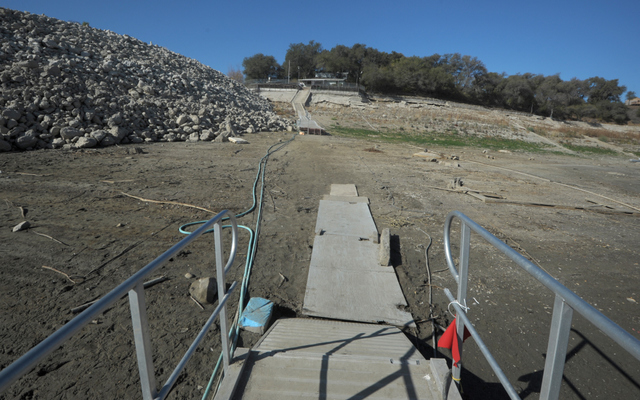Lake Cachuma May Be Drying Up Faster Than Expected
Water Agencies Desperately Want to Dip into Steelhead Reserves

Lake Cachuma may be going dry much faster than previously expected, meaning South Coast water agencies could find themselves forced to cut back by an additional one-third — or 3,126 acre-feet — between now and October 1. That cut would be on top of the 55 percent reduction agencies have already imposed upon themselves in deference to the drought.
Until last week, it was thought the lake wouldn’t go dry — at least on paper — until October 1. Now, the Santa Barbara County Water Agency is releasing new estimates indicating the end could come even sooner than that. Or not.
This lack of certainty reflects the difficulty inherent in calculating how many drops of water remain before the lake runs dry. As county agency chief Tom Fayram noted, “We’ve never been here before. That’s what unprecedented means.” The rate of evaporation, for example, is determined by heat and wind, both highly variable.
Compounding confusion is the reality that there’s far more water in the lake than the water agencies can get their hands on. A big chunk — about as much as the City of Santa Barbara uses in a year — has to be released to satisfy the legal entitlements of downstream users. About the same amount — 12,000 acre-feet — is deemed too scuzzy to be treated to drinking standards. Another 3,500 acre-feet has been set aside for the survival of the endangered steelhead trout.
If that fish water was made available, water agency directors contend, no additional cuts would be necessary. Specifically, the water has been set aside for use only to maintain a continuous flow — in the event of flash storm events — so that steelhead migrating upstream do not find themselves stranded after the storm ends and stretches of creek dry out.
Managers of local water agencies are seeking federal permission to dip into this fish account to stave off the drought with the promise of paying it back when future rains fall. The Santa Ynez River is so dry, they contend, that there’s no way any steelhead could get up its mouth, let alone get stranded.
Hashing this matter out is the Bureau of Reclamation — which built and owns the dam — and the National Marine Fisheries Service (NMFS), charged with protecting endangered species. These federal agencies don’t answer to local water purveyors. The status of these discussions remains a matter of mystery and exasperation for local water managers.
Without access to water from this fish account, local agencies will be forced to pump more water from their groundwater basins than they’ve pumped since the last drought. To do so, most agencies are now scrambling to get their respective batteries of water wells at the requisite capacity.
For the Goleta Water District in particular, this poses special challenges. Goleta — which declared a Stage III drought emergency this week — lacks the infrastructure necessary to pump well water to about 23 agricultural customers who operate orchards on the very west end of the district. These growers consume about 200 acre-feet a year and are equipped to take only untreated water from Lake Cachuma. Without any flow from the lake, their circumstances are dire.



